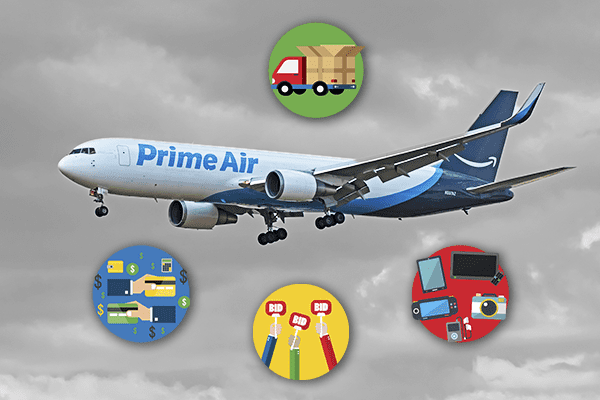Late last year, Amazon introduced their new Sponsored Ad format, Sponsored Display. This is a cost-per-click display ad format with simple, automatically generated creative. There’s several different targeting options, all based on things other than search terms. Depending on the targeting settings, this ad format shows on or off Amazon.com.
This is pretty different from Sponsored Products and Sponsored Brands, especially since advertisers aren’t targeting search terms. So, when is the best time to use this ad format, and what’s the best way to use it?
Sponsored Display vs. Amazon DSP
Although this is a display ad format, it is very different from Amazon’s DSP. Advertisers can set up Sponsored Display in the advertising console or Seller Central, while Amazon’s DSP is available through an Amazon representative or their self-service platform. Sponsored Display’s settings are much more simple to navigate than DSP, making this a great way for beginners to work with display advertising.
Some key differences between the two are that Sponsored Display is CPC, while DSP is typically priced via CPM (cost per mille or cost per thousand impressions). Sponsored Display automatically generates creative with the product image and title, while DSP allows custom creative.
Amazon’s DSP offers a myriad of targeting options, which can be drilled down by specifics such as interests, location, and even product views with 30- or 90-day lookback windows. Sponsored Display offers three targeting options, which provide ample opportunity, but are not as sophisticated as Amazon’s DSP.
Sponsored Display Results
Although display ad formats are often associated with impressions and awareness, Sponsored Display can provide substantial results when it comes to actual sales. One ROI client saw an 85% increase in sales year-over-year after implementing Sponsored Display campaigns. 25-30% of ad sales came from the Sponsored Display retargeting campaigns this client was running.
Would you like to see similar results with Amazon Sponsored Display? Keep reading for an overview of the ad type and how to best leverage it in your account.
Our Amazon Prime Day 2020 Prep video series covers everything brands need to know to navigate the “new normal” for Prime Day. Watch the four-part video series today to uncover strategies & insights around everything from inventory planning to merchandising and SEO readiness to digital advertising strategies.
Sponsored Display Targeting Options
To form a great Sponsored Display strategy, you’ll first need to understand the different targeting this ad format offers. There are two targeting groups: Audiences and Product Targeting, each with options within them. Audiences offer Views Targeting and Interest Targeting. Product Targeting offers just that, as well as Category Targeting.
All these targeting options show on Amazon.com except one: Views Targeting. This targeting options allows you to serve ads off Amazon.com Interest Targeting is different from the others in that it’s only available to Vendors right now, while the others are available to both Vendors and Sellers.
Audiences
12/9/2020 update: Amazon has recently introduced Views Remarketing, a retargeting option that also serves on Amazon.com. Click here to read more!
Sponsored Display’s Audiences, unlike other display options like Amazon DSP, does not offer granular targeting settings to choose from. It offers two audiences: Views and Interests. First, let’s talk about the Views option.
With Views Targeting, you can retarget shoppers who have previously viewed your product. Sponsored Display ads with this targeting setting appear off Amazon.com. This is similar to ads you’ll see “follow” you around the Internet, reminding you of a product you looked at but did not purchase.
This is a great way for advertisers on Amazon to set up retargeting (sometimes referred to as remarketing) campaigns without going through Amazon’s DSP.
Product Targeting
Product Targeting offers a little more in the way of choices, as it allows you to target Amazon products or product categories. With this setting, your ads will appear alongside products that you either hand-select, or that are in the category you chose. Ads with this targeting setting deliver on Amazon.com only.
Because you can choose individual products or categories, this targeting option is very versatile. First, let’s discuss product targeting. This setting allows you to enter a list of ASINs you want to target. Then, it offers separate bids per target, so you can routinely manage bids to optimize for profitability and return. If one of the ASINs targeted is not profitable, you can simply bid down that target or turn it off completely.
![]() This allows for ultra-specific competitor targeting campaigns, where advertisers can not only choose which competitor products to target, but also tailor these product groups around a specific strategy. For example, you might set up a competitor targeting campaign where only comparable products that could be directly substituted for your product are targeted.
This allows for ultra-specific competitor targeting campaigns, where advertisers can not only choose which competitor products to target, but also tailor these product groups around a specific strategy. For example, you might set up a competitor targeting campaign where only comparable products that could be directly substituted for your product are targeted.
Another strategy would be to target products you believe customers are likely to bounce off of, such as a product with a higher price point or lower star rating. The list goes on – target cheaper products, older products, products with less color options – there are lots of possibilities with Product Targeting in Sponsored Display.
Another way to use Product Targeting is to target your own products. The goal here is to upsell customers to better models, or encourage them to buy more at once, increasing the average order value (AOV). If you have a product with a low conversion rate, and would prefer shoppers browse a more popular product, you can target that poorer product with your top product. Your ads will show up right on the product detail page, and promote awareness of and clicks to the better product.
Category Targeting
Category Targeting, available under Product Targeting, is a great way to use Sponsored Display with a more broad approach, or if you don’t have specific ASINs you plan to target. This targeting option lends itself best to an awareness goal, because it casts a wide net and has the potential to gain lots of impressions. This can help support product launches or new brands.
Category Targeting is also useful for advertisers who are struggling to get clicks in their Sponsored Products campaigns with keyword targeting. If category search terms are too competitive to break into via keyword targeting, Sponsored Display’s Category Targeting can help by showing the product to shoppers browsing certain categories, increasing brand recall.
Interest Targeting
The final targeting option Sponsored Display offers to Vendors only is Interest Targeting, available under Audiences. This setting is similar to other display ad platforms as it targets individuals. Rather than product categories themselves, this targeting option follows shoppers who’ve exhibited browsing behavior that indicate certain interests. With this targeting group, your ads appear on Amazon.com wherever the targeted shopper is rather than on specific product pages.
This targeting option is common in the display world, and is another way for advertisers to easily use display advertising. For Sponsored Display, Interest Targeting is based on a 90-day lookback window. This longer timeframe could mean that the shopper has continued interest, but it could also mean that they have already purchased what they were looking for. It’s worth testing and seeing what works best for your specific category.
 Is Sponsored Display a Good Fit for Your Brand?
Is Sponsored Display a Good Fit for Your Brand?
Like all ad formats, Sponsored Display has pros and cons. To understand if Sponsored Display is right for your advertising strategy, consider these pros and cons.
Pros:
- Easy to set up with little barrier to entry, making it easy for display beginners to run campaigns
- Great complement to your Sponsored Products and Sponsored Brands ad strategy, as it provides unique placements on Amazon.com that can’t be obtained through the other ad types
- Supports a comprehensive Amazon advertising strategy, allowing for more brand exposure and coverage
- Auto-generates creative, making it easier to run display ads since no design work is required
- Runs on a cost-per-click pricing model, which is good for advertisers with a ROAS goal
Cons:
- More simple and fewer options than Amazon’s DSP
- No way to upload custom audiences or fine-tune with multiple audience filters
- Does not provide details on what websites the ads appeared on for Views Targeting
- Does not allow for custom creative, which can be a huge factor in a display campaign’s success
We have all of your Prime Day news covered. Stay tuned to our Amazon Prime Day 2020 blog page for all the latest news throughout the next several weeks as we approach the unprecedented shopping event.


 Our
Our 


